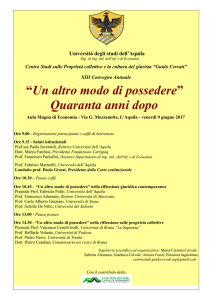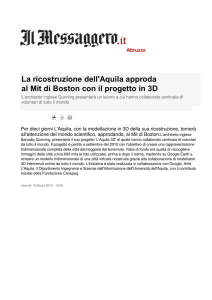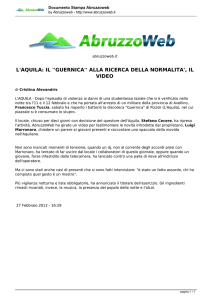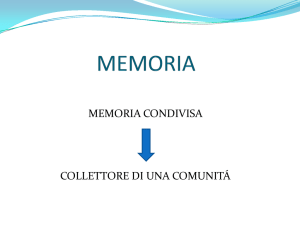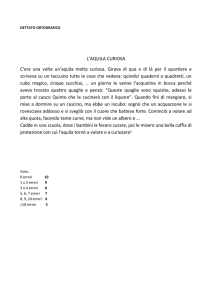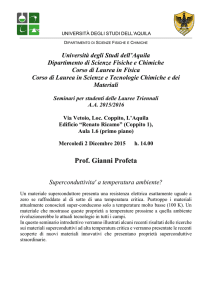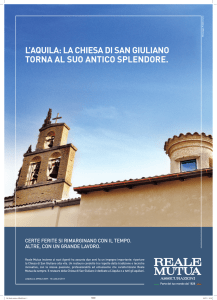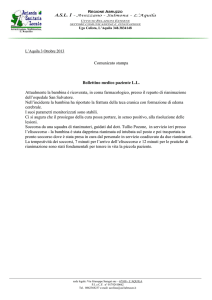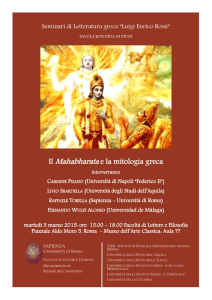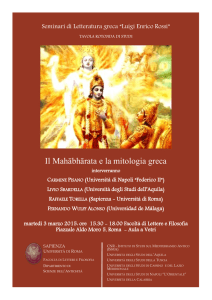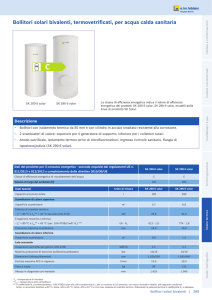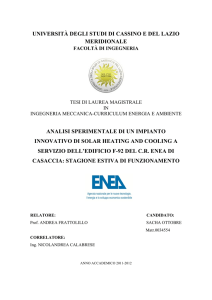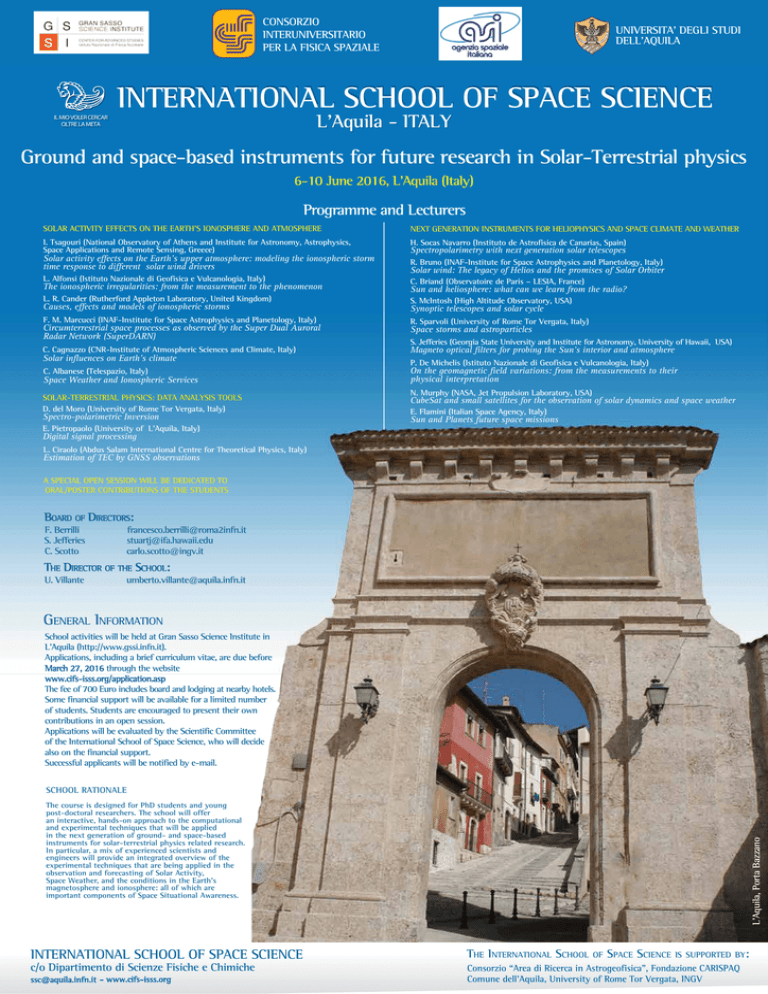
CONSORZIO
INTERUNIVERSITARIO
PER LA FISICA SPAZIALE
IL
ILMIO
MIOVOLER
VOLERCERCAR
CERCAR
OLTRE
OLTRELA
LAMETA
META
UNIVERSITA’ DEGLI STUDI
DELL’AQUILA
INTERNATIONAL SCHOOL OF SPACE SCIENCE
L’Aquila - ITALY
Ground and space-based instruments for future research in Solar-Terrestrial physics
6-10 June 2016, L'Aquila (Italy)
Programme and Lecturers
SOLAR ACTIVITY EFFECTS ON THE EARTH’S IONOSPHERE AND ATMOSPHERE
NEXT GENERATION INSTRUMENTS FOR HELIOPHYSICS AND SPACE CLIMATE AND WEATHER
I. Tsagouri (National Observatory of Athens and Institute for Astronomy, Astrophysics,
Space Applications and Remote Sensing, Greece)
H. Socas Navarro (Instituto de Astrofisica de Canarias, Spain)
Solar activity effects on the Earth’s upper atmosphere: modeling the ionospheric storm
time response to different solar wind drivers
Spectropolarimetry with next generation solar telescopes
R. Bruno (INAF-Institute for Space Astrophysics and Planetology, Italy)
Solar wind: The legacy of Helios and the promises of Solar Orbiter
L. Alfonsi (Istituto Nazionale di Geofisica e Vulcanologia, Italy)
C. Briand (Observatoire de Paris – LESIA, France)
L. R. Cander (Rutherford Appleton Laboratory, United Kingdom)
S. McIntosh (High Altitude Observatory, USA)
The ionospheric irregularities: from the measurement to the phenomenon
Causes, effects and models of ionospheric storms
F. M. Marcucci (INAF-Institute for Space Astrophysics and Planetology, Italy)
Circumterrestrial space processes as observed by the Super Dual Auroral
Radar Network (SuperDARN)
C. Cagnazzo (CNR-Institute of Atmospheric Sciences and Climate, Italy)
Solar influences on Earth’s climate
C. Albanese (Telespazio, Italy)
Space Weather and Ionospheric Services
SOLAR-TERRESTRIAL PHYSICS: DATA ANALYSIS TOOLS
D. del Moro (University of Rome Tor Vergata, Italy)
Spectro-polarimetric Inversion
E. Pietropaolo (University of L’Aquila, Italy)
Sun and heliosphere: what can we learn from the radio?
Synoptic telescopes and solar cycle
R. Sparvoli (University of Rome Tor Vergata, Italy)
Space storms and astroparticles
S. Jefferies (Georgia State University and Institute for Astronomy, University of Hawaii, USA)
Magneto optical filters for probing the Sun’s interior and atmosphere
P. De Michelis (Istituto Nazionale di Geofisica e Vulcanologia, Italy)
On the geomagnetic field variations: from the measurements to their
physical interpretation
N. Murphy (NASA, Jet Propulsion Laboratory, USA)
CubeSat and small satellites for the observation of solar dynamics and space weather
E. Flamini (Italian Space Agency, Italy)
Sun and Planets future space missions
Digital signal processing
L. Ciraolo (Abdus Salam International Centre for Theoretical Physics, Italy)
Estimation of TEC by GNSS observations
A SPECIAL OPEN SESSION WILL BE DEDICATED TO
ORAL/POSTER CONTRIBUTIONS OF THE STUDENTS
BOARD OF DIRECTORS:
F. Berrilli
S. Jefferies
C. Scotto
[email protected]
[email protected]
[email protected]
THE DIRECTOR OF THE SCHOOL:
U. Villante
[email protected]
GENERAL INFORMATION
School activities will be held at Gran Sasso Science Institute in
L’Aquila (http://www.gssi.infn.it).
Applications, including a brief curriculum vitae, are due before
March 27, 2016 through the website
www.cifs-isss.org/application.asp
The fee of 700 Euro includes board and lodging at nearby hotels.
Some financial support will be available for a limited number
of students. Students are encouraged to present their own
contributions in an open session.
Applications will be evaluated by the Scientific Committee
of the International School of Space Science, who will decide
also on the financial support.
Successful applicants will be notified by e-mail.
SCHOOL RATIONALE
L'Aquila, Porta Bazzano
The course is designed for PhD students and young
post-doctoral researchers. The school will offer
an interactive, hands-on approach to the computational
and experimental techniques that will be applied
in the next generation of ground- and space-based
instruments for solar-terrestrial physics related research.
In particular, a mix of experienced scientists and
engineers will provide an integrated overview of the
experimental techniques that are being applied in the
observation and forecasting of Solar Activity,
Space Weather, and the conditions in the Earth’s
magnetosphere and ionosphere: all of which are
important components of Space Situational Awareness.
INTERNATIONAL SCHOOL OF SPACE SCIENCE
THE INTERNATIONAL SCHOOL OF SPACE SCIENCE IS SUPPORTED BY:
[email protected] - www.cifs-isss.org
Consorzio “Area di Ricerca in Astrogeofisica”, Fondazione CARISPAQ
Comune dell’Aquila, University of Rome Tor Vergata, INGV
c/o Dipartimento di Scienze Fisiche e Chimiche

